
Mattapoisett is a town in Plymouth County, Massachusetts, United States. The population was 6,508 at the 2020 census. Mattapoisett Center is located in the town.
Corbitant was a Wampanoag sachem under Massasoit. Corbitant was the sachem of the Pocasset tribe in present-day North Tiverton, Rhode Island, c. 1618–1630. He lived in Mattapuyst or Mattapoiset, located in the southern part of today's Swansea, Massachusetts.
The Fairhaven Branch Railroad was a short-line railroad in Massachusetts. It ran from West Wareham on the Cape Cod main line of the Old Colony Railroad, southwest to Fairhaven, a town across the Acushnet River from New Bedford.

The shingle style is an American architectural style made popular by the rise of the New England school of architecture, which eschewed the highly ornamented patterns of the Eastlake style in Queen Anne architecture. In the shingle style, English influence was combined with the renewed interest in Colonial American architecture which followed the 1876 celebration of the Centennial. The plain, shingled surfaces of colonial buildings were adopted, and their massing emulated.
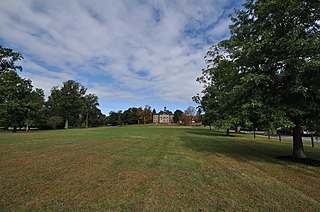
The Woodstock Hill Historic District is a historic district encompassing the historic village center of Woodstock, Connecticut. It is centered on the Woodstock Green, extending south from there toward the junction of Connecticut Route 169 and Plaine Hill Road. Major buildings in the district include the 1821 Congregational Church, the buildings of Woodstock Academy, and Roseland Cottage, a National Historic Landmark that is one of the nation's finest Gothic Revival summer houses. The district was listed on the National Register of Historic Places in 1999.
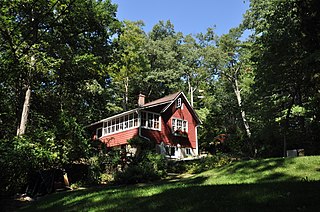
The Russian Village Historic District, also known as Churaevka, is a historic summer colony founded by George Grebenstchikoff and Ilya Tolstoy in Southbury, Connecticut. The colony was founded in the 1920s by Russian emigres, and retains distinctive Russian touches in the architecture of its houses, as well as a small chapel designed by Nicholas Roerich. The colony was listed on the National Register of Historic Places in 1988.

Swansea Village Historic District is a historic district roughly along Main Street from Gardners Neck Road to Stephens Road, and Ledge Road in Swansea, Massachusetts. The district encompasses what emerged in the late 18th century as the principal municipal center of the town. The area that became Swansea Village was owned until about 1720 by members of the Eddy family, whose family graveyard lies in the district. By the early 19th century the junction of Main, Elm, and Stephens began to take shape as the nucleus of the village, and a meeting house, library, and eventually town hall followed.
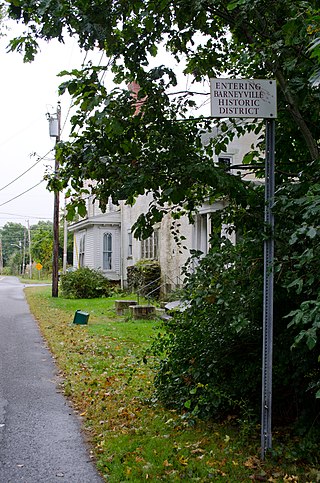
The Barneyville Historic District is a predominantly residential historic district on Old Providence and Barneyville Roads in northwestern Swansea, Massachusetts. The area was the site of a successful shipbuilding operation during the early 19th century, and then became a local center for jewelry making. The district was added to the National Register of Historic Places in 1990.

Hortonville is a village in the town of Swansea, Bristol County, Massachusetts, United States. The part of the village on Locust Street from Oak Street to Hortonville Road comprises the Hortonville Historic District, which was listed on the National Register of Historic Places in 1990.

The Third Meetinghouse is an historic church, community meeting house and Grange Hall at 1 Fairhaven Road in Mattapoisett, Massachusetts. Built in 1816, it is the town's oldest surviving public building, and the one in which the meeting leading to its separation from Rochester took place. The building was added to the National Register of Historic Places in 1976.
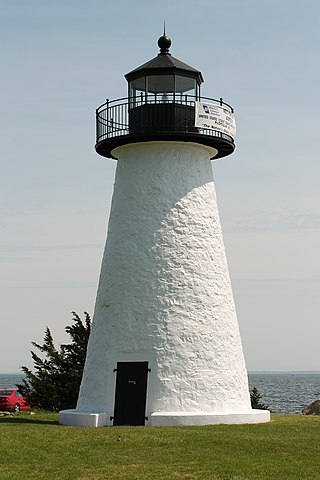
Ned Point Light is a historic lighthouse on Ned's Point Road in Mattapoisett, Massachusetts. The lighthouse was built in 1838 at a cost of approximately $5,000, and named after Ned Dexter, a local farmer. Under the supervision of a local builder, Leonard Hammond, the lighthouse was constructed with a birdcage-style lantern similar to Bird Island Light found in Marion, Massachusetts. The stone used for the lighthouse was all locally sourced, with most of it originating from nearby beaches. Inside, there are 32 granite steps that are cantilevered to the outside wall without the use of mortar. The original lantern used 11 whale oil lamps, each with its own parabolic reflector. The lamps and reflectors were replaced by a fifth order Fresnel lens in 1857, along with a change to an octagonal lantern. The Great Blizzard of 1888 significantly damaged the keeper's stone house, resulting in it being demolished and the building of a wooden replacement.

The Wianno Historic District is a historic district in the Osterville section of Barnstable, Massachusetts. It encompasses a well-preserved summer resort area for the wealthy that was first developed in the late 19th century, focused around the Wianno Club, built in 1881 on the site of an earlier resort hotel. The 40-acre (16 ha) district has a significant number of well-preserved Shingle style and Colonial Revival houses. Architect Horace Frazer designed the Wianno Club, as well as a number of the private residences in the district. The district is roughly bounded by East Bay Road, Wianno and Sea View Avenues between Nantucket Sound and Crystal Lake. It was added to the National Register of Historic Places in 1987.

The Glen Road Historic District is a historic district at 233-317 Glen Road in Weston, Massachusetts. The district encapsulates historical development trends in Weston, in which land began in agricultural uses, and was later transformed into either resort or suburban residential housing. It is also notable for its longtime association with the Jennings family, who owned the land from the 18th century into the 20th, and engaged in all three land uses. The district was listed on the National Register of Historic Places in 2006.

The H. H. Richardson Historic District of North Easton is a National Historic Landmark District in the village of North Easton in Easton, Massachusetts. It consists of five buildings designed by noted 19th-century architect Henry Hobson Richardson, and The Rockery, a war memorial designed by Frederick Law Olmsted. It was declared a National Historic Landmark in 1987.
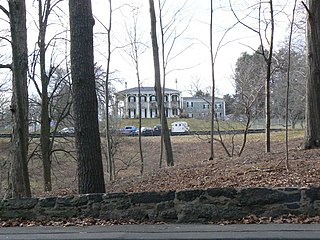
The Green Hill Historic District encompasses historical cross-section of residential housing in Brookline, Massachusetts, dating from the 18th century into the mid-20th century. The district includes properties on Warren, Cottage, and Fairmount Streets, and on Sargent Road, centered on the junction of Warren and Cottage Streets. The oldest houses date to the mid-18th century, and were originally modest Georgian or Federal structures. During the 19th century the area was populated by the summer estates of some of Boston's leading merchant and business families, including members of the Cabot and Perkins families. During the later 19th and early 20th centuries some of Brookline's largest and most architecturally interesting homes were built in this area.
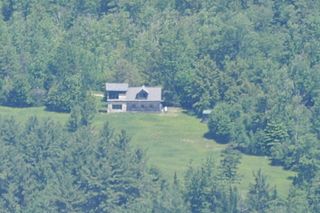
The Lattice Cottage is a historic summer house on the slopes of Mount Monadnock in Dublin, New Hampshire, United States. Built as an estate guest house in 1929 to a design by Harry Little of Boston, Massachusetts, it is a distinctive example of Arts and Crafts architecture.
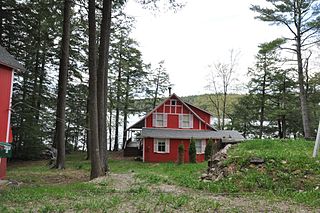
The Silver Lake District is a historic district encompassing a summer resort area along the southern section of Silver Lake in Harrisville, New Hampshire. It includes a collection of summer cottages built along or near the shores of the lake between about 1880 and 1903, a period of prosperity in Harrisville and nearby Keene. It is unusual in that most of the owners and occupants of its properties were from nearby towns, and not from further afield, as the populations of the summer colonies of Nelson and Dublin were. The district covers 66 acres (27 ha) from the town line between Harrisville and Nelson to the southern end of the lake, and includes 76 contributing buildings. It was listed on the National Register of Historic Places in 1986.
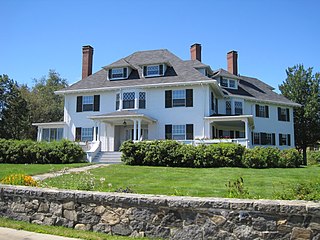
The Little Boar's Head Historic District encompasses an area of summer resort and beachfront properties in North Hampton, New Hampshire. Located on New Hampshire's seacoast roughly between North Hampton State Beach and Bass Beach, the district is almost entirely residential, consisting mainly of houses built as summer vacation spots in the late 19th and early 20th centuries, with associated beachfront amenities. The district was listed on the National Register of Historic Places in 1999.
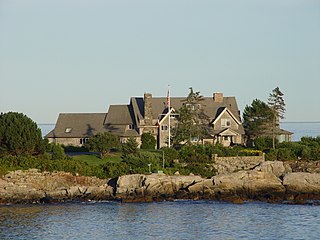
The Cape Arundel Summer Colony Historic District encompasses an enclave of large summer estates on the coast of Kennebunkport, Maine. The area was developed in the late 19th and early 20th century as a resort area for the wealthy of the northeastern United States. It notably includes the Kennebunk River Club and Walkers Point, the location of the Bush compound, which has a Shingle-style house built in 1903. The district was listed on the National Register of Historic Places in 1984.

The Auburn–Harpswell Association Historic District encompasses a well-preserved enclave of summer residences built in the early 20th century in southern Harpswell, Maine. The district includes ten Shingle style houses, a Colonial Revival dining hall, and a Greek Revival meeting hall. The Auburn Colony, an exclusive company of businessmen from Auburn, Maine, was responsible for their development. The district was listed on the National Register of Historic Places in 1985.





















